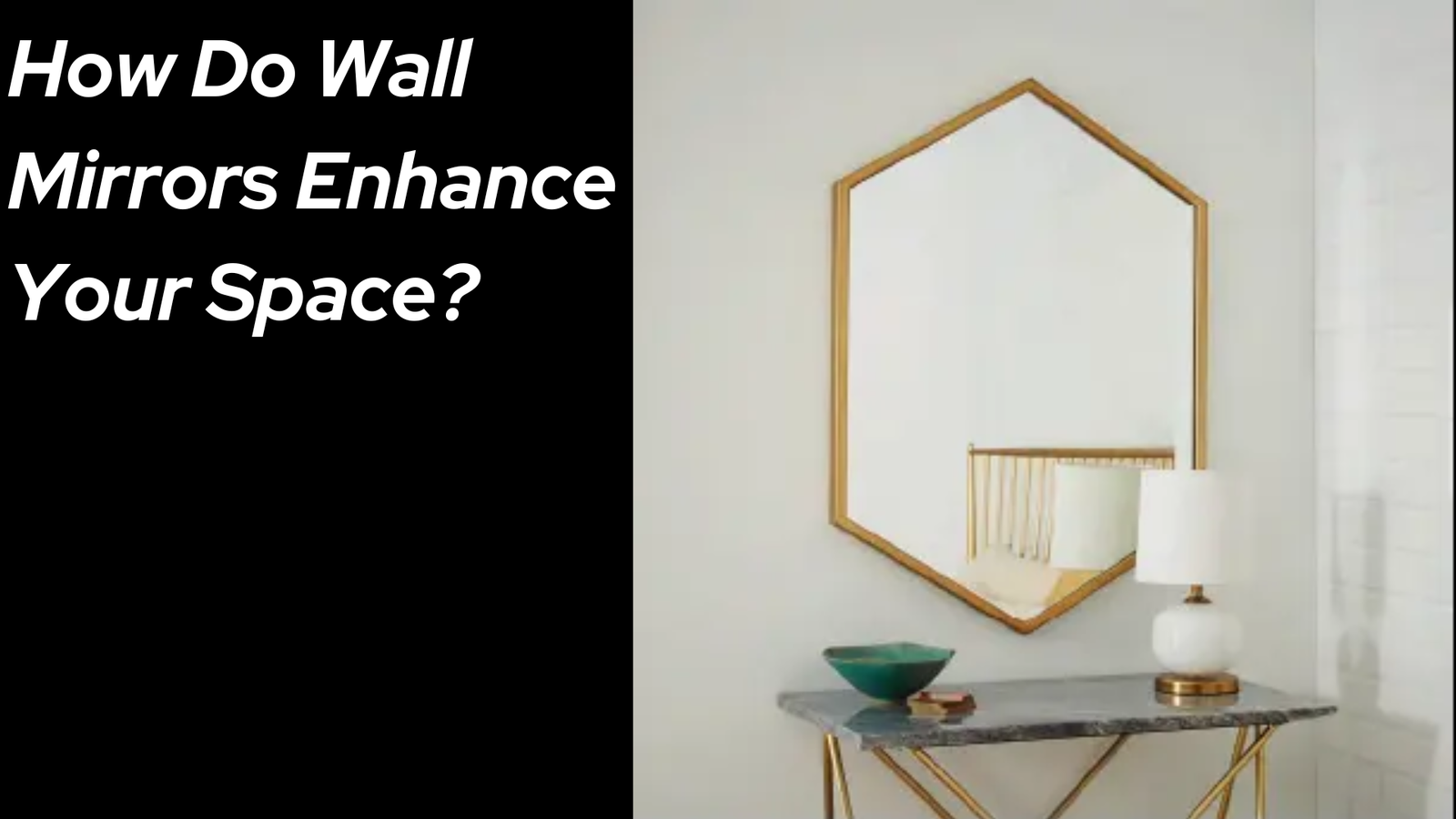Wall mirrors have long been used not only for their functional role but also as a key element in interior design. They offer an elegant solution to many design challenges and can dramatically transform the aesthetic of any space. The versatility of wall mirrors makes them a powerful tool for enhancing the ambiance and appearance of a room. Whether you’re aiming to create an illusion of space, improve lighting, or add a decorative touch, wall mirrors provide a myriad of benefits. This article delves into the ways wall mirrors can enhance your space, providing insights into how to effectively use them in your home or office environment.
The Role of Wall Mirrors in Interior Design
Wall mirrors are an essential part of interior design, contributing both practicality and style. Interior designers frequently use mirrors to address a wide range of design objectives, including enhancing the visual appeal of a room, improving its functionality, and even altering its perceived dimensions.
Note: Customers in Dubai appreciated the elegance that Wall Mirrors Dubai added to their homes. Glassmirror provided a variety of stylish options that perfectly complemented their decor. Many chose unique designs to enhance their spaces. If you seek to elevate your interiors, contact Glassmirror for stunning wall mirrors today!
Aesthetic Appeal
One of the most straightforward ways that wall mirrors enhance your space is by adding a visual element that complements or enhances the existing decor. Mirrors come in various shapes, sizes, and styles, allowing them to fit seamlessly into any design scheme. From minimalist frameless mirrors to ornate, decorative frames, the design possibilities are endless. Wall mirrors can serve as a focal point in a room, especially when placed over fireplaces, in hallways, or above consoles, adding sophistication and style.
Functionality and Practical Use
Aside from their decorative role, wall mirrors are extremely functional. They serve a practical purpose by allowing individuals to check their appearance, making them indispensable in spaces such as bathrooms, bedrooms, and entryways. But beyond this, they also contribute to the overall functionality of a room by reflecting light and amplifying space, which is particularly useful in smaller or dimly lit rooms.
Creating the Illusion of Space with Wall Mirrors
One of the most significant contributions of wall mirrors to interior design is their ability to create the illusion of space. This makes them a particularly valuable asset in smaller rooms or apartments where space is limited.
Making Small Spaces Feel Larger
Mirrors have the remarkable ability to make a room feel larger than it actually is. By reflecting the surrounding environment, they give the illusion of extended space. This is particularly effective when mirrors are placed opposite windows or in strategic locations where they can reflect light or open areas. In narrow hallways or small living rooms, large wall mirrors can make the area feel more spacious and less confined.
Reflecting Open Spaces
In larger rooms, mirrors can be used to reflect open spaces, enhancing the sense of continuity and flow within a room. For example, placing a mirror in a room with high ceilings or large windows can emphasize the room’s natural openness and make it feel even more expansive. In open-plan living areas, mirrors can help maintain a sense of coherence by visually connecting different parts of the room.
Enhancing Natural Light with Wall Mirrors
Another significant benefit of wall mirrors is their ability to improve the lighting within a room. Reflecting both natural and artificial light, mirrors can brighten up a space and reduce the need for additional light sources.
Amplifying Natural Light
In rooms where natural light is limited, mirrors can play a crucial role in amplifying the available light. By placing a wall mirror opposite or adjacent to a window, you can reflect the natural light throughout the room, making it feel brighter and more welcoming. This can be especially beneficial in spaces like basements or rooms with small windows, where natural light may be scarce.
Enhancing Artificial Lighting
In addition to enhancing natural light, mirrors can also be used to boost artificial lighting in a room. Strategically positioning mirrors near light fixtures, such as chandeliers or lamps, can help to reflect and disperse light more evenly across the room. This creates a well-lit environment without the need to add extra lighting fixtures, contributing to both energy efficiency and a more inviting atmosphere.
Adding Depth and Dimension with Wall Mirrors
Mirrors do more than just reflect—they also create depth and dimension, adding an extra layer of complexity to a room’s design. This can be particularly useful in spaces that feel flat or one-dimensional.
Enhancing Room Depth
Mirrors can create the illusion of depth, making a room feel more dynamic. In rooms that might otherwise feel boxy or confined, a well-placed mirror can make the space feel more open and layered. For instance, placing a large mirror on a feature wall can give the impression that the room extends further than it actually does, adding a sense of depth and richness to the space.
Creating Visual Interest
In addition to enhancing depth, mirrors can be used to create visual interest within a room. When used as part of a gallery wall or incorporated into a decorative arrangement, mirrors can break up the monotony of flat surfaces and add a reflective quality that catches the eye. This helps to create a more engaging and dynamic visual experience, making the room feel more thoughtfully designed.
Using Wall Mirrors as a Decorative Element
Mirrors aren’t just functional—they can also serve as stunning decorative elements that elevate the overall look of a room. Their reflective surface can complement other design features and add an element of luxury or sophistication.
Statement Pieces
Wall mirrors can act as statement pieces in a room, especially when they have ornate frames or unique shapes. A large, intricately framed mirror can serve as the focal point of a room, drawing attention and adding a sense of elegance or drama. Statement mirrors are particularly effective in living rooms, dining areas, or entryways, where they can set the tone for the entire space.
Complementing Existing Decor
Mirrors also have the ability to complement the existing decor without overpowering it. A minimalist, frameless mirror, for example, can blend seamlessly into a contemporary design scheme, while a rustic, wooden-framed mirror can enhance a more traditional or cozy aesthetic. Mirrors can reflect and enhance the color palette of a room, adding to the overall harmony and cohesion of the design.
Choosing the Right Wall Mirror for Your Space
The key to maximizing the benefits of wall mirrors lies in selecting the right mirror for your space. Factors such as size, shape, frame style, and placement all play a role in how effectively a mirror enhances your room.
Size and Scale
Choosing the right size of mirror is crucial for achieving the desired effect. In small spaces, oversized mirrors can help to create the illusion of more space, while in larger rooms, a small mirror might feel out of place. When selecting a mirror, consider the size of the wall and the surrounding furniture to ensure the mirror feels proportionate to the space.
Shape and Style
The shape and style of a mirror can also impact its overall effect on a room. Round mirrors, for instance, are often used to soften the angular lines of a room, while rectangular or square mirrors can provide a more structured, formal look. The style of the frame—whether sleek and modern or ornate and traditional—should complement the room’s decor and add to the overall design scheme.
Placement and Positioning
The placement of a mirror is perhaps the most important factor in determining its impact on a room. For example, placing a mirror opposite a window can reflect natural light, while positioning it above a fireplace can create a dramatic focal point. Consider the purpose of the mirror—whether it’s meant to add light, create space, or serve as decoration—and position it accordingly.
The Versatility of Wall Mirrors in Different Spaces
Wall mirrors can be used effectively in nearly any room in the house, from the living room to the bathroom. Their versatility makes them a valuable addition to a wide range of spaces.
Living Rooms and Bedrooms
In living rooms and bedrooms, mirrors are often used to create a focal point or to enhance the natural light. A large mirror above the bed or couch can anchor the room and make it feel more complete, while a strategically placed mirror can reflect outdoor views and bring a sense of nature indoors.
Bathrooms and Entryways
In bathrooms, mirrors are essential for functionality, but they can also add to the design by reflecting light and making the space feel larger. In entryways, mirrors can provide the finishing touch to a welcoming space, allowing for last-minute checks before heading out the door while also brightening the area.
Conclusion
Wall mirrors are more than just reflective surfaces—they are a powerful design tool that can transform the look and feel of any space. From creating the illusion of space and enhancing natural light to adding depth and serving as decorative elements, mirrors offer a versatile solution to a wide range of interior design challenges. By choosing the right mirror for your room and positioning it thoughtfully, you can enhance your space’s aesthetics, functionality, and ambiance. Whether you’re looking to make a small room feel larger, brighten up a dimly lit space, or simply add a stylish focal point, wall mirrors are an essential addition to any home or office.
For More Isightful Articles Related To This Topic, Feel Free To Visit: empireadda



